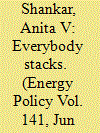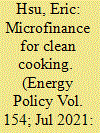|
|
|
Sort Order |
|
|
|
Items / Page
|
|
|
|
|
|
|
| Srl | Item |
| 1 |
ID:
110693


|
|
|
|
|
| Publication |
2011.
|
| Summary/Abstract |
Indoor air pollution from burning solid fuels for cooking is a major environmental health problem in developing countries, predominantly affecting children and women. Traditional household energy practices also contribute to substantial time loss and drudgery among households. While effective interventions exist, levels of investment to date have been very low, in part due to lack of evidence on economic viability. Between 2004 and 2007, different combinations of interventions - improved stoves, smoke hoods and a switch to liquefied petroleum gas - were implemented in poor communities in Nepal, Sudan and Kenya. The impacts were extensively evaluated and provided the basis for a household-level cost-benefit analysis, which essentially followed the methodology proposed by the World Health Organization. The results suggest that interventions are justified on economic grounds with estimated internal rates of return of 19%, 429% and 62% in Nepal, Kenya and Sudan, respectively. Time savings constituted by far the most important benefit followed by fuel cost savings; direct health improvements were a small component of the overall benefit. This paper describes the methodology applied, discusses the findings and highlights the methodological challenges that arise when a global approach is applied to a local programme.
|
|
|
|
|
|
|
|
|
|
|
|
|
|
|
|
| 2 |
ID:
132618


|
|
|
|
|
| Publication |
2014.
|
| Summary/Abstract |
The reuse of Li-ion EV batteries for energy storage systems (ESS) in stationary settings is a promising technology to support improved management of demand and supply of electricity. In this paper, MatLAB simulation of a residential energy profile and regulated cost structure is used to analyze the feasibility of and cost savings from repurposing an EV battery unit for peak-shifting. in situ residential energy storage can contribute to the implementation of a smart grid by supporting the reduction of demand during typical peak use periods. Use of an ESS increases household energy use but potentially improves economic effectiveness and reduces greenhouse gas emissions. The research supports the use of financial incentives for Li-ion battery reuse in ESS, including lower energy rates and reduced auxiliary fees.
|
|
|
|
|
|
|
|
|
|
|
|
|
|
|
|
| 3 |
ID:
175024


|
|
|
|
|
| Summary/Abstract |
Stove stacking (concurrent use of multiple stoves and/or fuels) is a poorly quantified practice in regions with ongoing efforts to transition household energy to cleaner options. Using biomass-burning stoves alongside clean stoves undermines health and environmental goals. This review synthesizes stove stacking data gathered from eleven case studies of clean cooking programs in low- and middle-income country settings. Analyzed data are from ministry and program records, research studies, and informant interviews. Thematic analysis identifiedy key drivers of stove stacking behavior in each setting. Significant (28%–100%) stacking with traditional cooking methods was observed in all cases. Reasons for traditional fuel use included: costs of clean fuel; mismatches between cooking technologies and household needs; and unreliable fuel supply. National household surveys often focus on 'primary' cookstoves and miss stove stacking data. Thus more attention should be paid to discontinuation of traditional stove use, not solely adoption of cleaner stoves/fuels. Future energy policies and programs should acknowledge the realities of stacking and incorporate strategies at the design stage to transition away from polluting stoves/fuels. Seven principles for clean cooking program design and policy are presented, focused on a shift toward "cleaner stacking" that could yield household air pollution reductions approaching WHO targets.
|
|
|
|
|
|
|
|
|
|
|
|
|
|
|
|
| 4 |
ID:
110694


|
|
|
|
|
| Publication |
2011.
|
| Summary/Abstract |
The health and climate impacts of available household cooking options in developing countries vary sharply. Here, we analyze and compare these impacts (health; climate) and the potential co-benefits from the use of fuel and stove combinations. Our results indicate that health and climate impacts span 2 orders of magnitude among the technologies considered. Indoor air pollution is heavily impacted by combustion performance and ventilation; climate impacts are influenced by combustion performance and fuel properties including biomass renewability. Emission components not included in current carbon trading schemes, such as black carbon particles and carbon monoxide, can contribute a large proportion of the total climate impact. Multiple 'improved' stove options analyzed in this paper yield roughly equivalent climate benefits but have different impacts on indoor air pollution. Improvements to biomass stoves can improve indoor air quality, which nonetheless remains significantly higher than for stoves that use liquid or gaseous hydrocarbons. LPG- and kerosene-fueled stoves have unrivaled air quality benefits and their climate impacts are also lower than all but the cleanest stoves using renewable biomass.
|
|
|
|
|
|
|
|
|
|
|
|
|
|
|
|
| 5 |
ID:
127287


|
|
|
|
|
| Publication |
2014.
|
| Summary/Abstract |
It is widely accepted that interventions designed to promote household energy efficiency, like insulation, central heating and double glazing, can help to reduce cold-related illnesses and associated stress by making it easier for residents to keep their homes warm. However, these interventions may also have a detrimental effect on health. For example, the materials used or lower ventilation rates could result in poorer indoor air quality. The present research sought to systematically quantify the impact of household energy efficiency measures on health and wellbeing. Thirty-six studies, involving more than 33,000 participants were meta-analysed. Effect sizes (d) ranged from ?0.43 (a negative impact on health) to 1.41 (a substantial positive impact on health), with an overall sample-weighted average effect size (d+) of 0.08. On average, therefore, household energy efficiency interventions led to a small but significant improvement in the health of residents. The findings are discussed in the context of the health improvements experienced by different groups of participants and the study design factors that influence health outcomes. The need for future studies to investigate the long term health benefits of interventions designed to promote household energy efficiency is identified.
|
|
|
|
|
|
|
|
|
|
|
|
|
|
|
|
| 6 |
ID:
180094


|
|
|
|
|
| Summary/Abstract |
Liquidity constraints are a key barrier to acquisition and sustained use of clean household energy in resource-poor settings. This study evaluates a pilot microfinance initiative in Kenya to help low-income rural households access liquefied petroleum gas (LPG) for cooking. Program beneficiaries received a six-month loan that covered all equipment costs and was to be repaid in monthly installments. We present results from surveys of beneficiaries (n = 69) after they began using LPG, as well as 332 non-beneficiaries from the same community (to understand how beneficiaries and non-beneficiaries differ in cooking patterns and socioeconomic outcomes). 94% of beneficiaries had repaid their loan in full and on time at the time of data collection. Meanwhile, beneficiaries were more likely than non-beneficiaries to use LPG as their primary cooking fuel (76.8% of beneficiaries versus 38.8% of non-beneficiaries). While 81.1% of beneficiaries who used LPG as their primary cooking fuel reported multiple fuel use, we find beneficiaries increased LPG use by 5.9 h per week with a corresponding decrease of 4.8 h in weekly use of biomass fuel. Our findings suggest that promoting LPG usage through microloans for equipment is likely to be both commercially viable and beneficial to health through decreased use of polluting biomass fuel.
|
|
|
|
|
|
|
|
|
|
|
|
|
|
|
|
| 7 |
ID:
127289


|
|
|
|
|
| Publication |
2014.
|
| Summary/Abstract |
Better methods of characterizing and addressing heterogeneity in preferences and decision making are needed to stimulate reductions in household greenhouse gas emissions. Four residential energy efficiency programs were delivered consecutively in the Region of Waterloo, Canada, between 1999 and 2011, and each offered a unique combination of information, financial reward structure, and price. A natural quasi-experimental intervention design was employed to assess differences in outcomes across these program structures. Participation at the initial (evaluation by an energy advisor) and follow-up (verification of retrofit) stages, and the material characteristics (e.g., energy performance) were measured and compared between the groups of houses included in each program at each stage. The programs appealed to people with different types of material concerns; each phase of the program was associated with houses with a different mix of material characteristics and depths of recommended and achieved changes. While a performance-based reward attracted fewer houses at each stage than a larger list-based reward, older houses with poorer energy performance were included at each stage. The findings support experimentation with program designs to target sub-populations of housing stock; future program designs should experiment more carefully and with larger performance-based rewards and test parallels with potential carbon market structures.
|
|
|
|
|
|
|
|
|
|
|
|
|
|
|
|
| 8 |
ID:
088969


|
|
|
|
|
| Publication |
2009.
|
| Summary/Abstract |
India is among the world lowest per capita greenhouse gas (GHG) emitters, but rapid increases are expected. At the same time, World Health Organization (WHO) estimates show that 424,000 die prematurely in Indian households each year from air pollution exposure due to solid fuel use. We analyze GHG emissions and health through three policy scenarios for household energy, using projections for population, income and urbanization. In policy scenarios called Business as Usual (BAU), Improved Health, and Green Future, projected per capita household GHG emissions in 2026 increase by 169%, 164% and 139%, respectively, compared to 2001, whereas household mortality rates decrease by 45%, 67% and 45%, respectively. Due to income growth and urbanization, an increase in GHG emissions is likely inevitable, but can be slowed. For health, in contrast, improvements are expected and can be expanded.
|
|
|
|
|
|
|
|
|
|
|
|
|
|
|
|
| 9 |
ID:
103602


|
|
|
|
|
| Publication |
2011.
|
| Summary/Abstract |
This paper addresses the topic of energy and development through a multi-disciplinary and systemic approach that combines environmental considerations with a social understanding of consumption. The focus is on electricity usage in the home and specifically lighting and cooling. Set in the urban mega-polis of Metro Manila, the Philippines, energy consumption is first placed in its biophysical perspective: the energy sources and electricity grid are presented, in relation to the Philippines as well as the region. The research findings then explore the social and cultural drivers behind household electricity consumption, revealing in several examples the strong influence of globalization-understood here as the flow of people, remittances, images and ideas. Policy recommendations are provided, based on the research results, with concluding remarks relevant to other similar contexts.
|
|
|
|
|
|
|
|
|
|
|
|
|
|
|
|
|
|
|
|
|